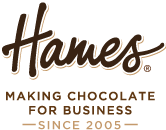Why is Lecithin used in Chocolate?

Why is Lecithin used in Chocolate?
Lecithin is an emulsifier used in chocolate to help bind together the fat-based ingredients such as cocoa butter, with the non-fat based ingredients such as sugar. Lecithin also works to lower the chocolate viscosity to allow the chocolate to flow, be tempered and to be moulded and worked more easily.
Typical milk chocolate bar ingredients are:
Milk Chocolate (Sugar, Whole Milk Powder, Cocoa Butter, Cocoa Mass, Natural Vanilla Flavouring, Emulsifier: Soya Lecithin)
You can see that the lecithin is the last ingredient in the list as not much is needed in the chocolate recipe.
Soya Lecithin comes from Soy Beans and it’s the most common type of lecithin in chocolate products, but Soy Beans are also one of the 14 main allergens that should be highlighted on product labelling in the UK.
Lecithin can be sourced from a variety of plants (also known as botanical lecithins) including Soya, Sunflower, Rapeseed, Safflower and Corn.
Hames Chocolates are committed to moving their chocolate grades to non-allergenic botanical lecithins. This will be a gradual process as all our packaging is currently labelled with soya lecithin and many of our chocolate raw materials still contain soya lecithin.
During 2022 we will start to amend our chocolate labelling so that we can begin the slow and gradual process of moving over to non-allergenic botanical lecithins. An example of this is below:
Milk Chocolate (Sugar, Whole Milk Powder, Cocoa Butter, Cocoa Mass, Natural Vanilla Flavouring, Emulsifier: Lecithin including Soya).
The gradual introduction of non-allergenic botanical lecithins will not affect the taste of our Great British chocolate.
Although our first thoughts are to change to Sunflower based lecithin, the recent development in Ukraine means that other botanical lecithins may be used.
For botanical lecithins that are not defined as substances and/or products causing allergies and
intolerances, we understand that no specific indication is required by the European Regulations:
- EU Regulation 1333/2008 on food additives defines additive E322 as lecithins.
- EU Regulation 1169/2011 Annex VII, Part C specifies that food additives must be designated by
the name of that category, followed by their specific name or, if appropriate, E number. Article 21
of the same regulation requires that substances or products causing allergies or intolerances shall
be indicated in the list of ingredients with a clear reference to the name of the substance or
product as listed in Annex II of the regulation.
We will continue to declare soya on our labelling, this is an allergen that is currently widely used within our chocolate factory.
For private label chocolate products the labelling, substantiation and decision making of the product is the brand owner's responsibility. We recommend you consult regulatory and legal advisors familiar with all applicable laws, rules and regulations in the country of sale prior to making labelling and claims decisions for your products.
Lecithin is an emulsifier used in chocolate to help bind together the fat-based ingredients such as cocoa butter, with the non-fat based ingredients such as sugar. Lecithin also works to lower the chocolate viscosity to allow the chocolate to flow, be tempered and to be moulded and worked more easily.
Typical milk chocolate bar ingredients are:
Milk Chocolate (Sugar, Whole Milk Powder, Cocoa Butter, Cocoa Mass, Natural Vanilla Flavouring, Emulsifier: Soya Lecithin)
You can see that the lecithin is the last ingredient in the list as not much is needed in the chocolate recipe.
Soya Lecithin comes from Soy Beans and it’s the most common type of lecithin in chocolate products, but Soy Beans are also one of the 14 main allergens that should be highlighted on product labelling in the UK.
Lecithin can be sourced from a variety of plants (also known as botanical lecithins) including Soya, Sunflower, Rapeseed, Safflower and Corn.
Hames Chocolates are committed to moving their chocolate grades to non-allergenic botanical lecithins. This will be a gradual process as all our packaging is currently labelled with soya lecithin and many of our chocolate raw materials still contain soya lecithin.
During 2022 we will start to amend our chocolate labelling so that we can begin the slow and gradual process of moving over to non-allergenic botanical lecithins. An example of this is below:
Milk Chocolate (Sugar, Whole Milk Powder, Cocoa Butter, Cocoa Mass, Natural Vanilla Flavouring, Emulsifier: Lecithin including Soya).
The gradual introduction of non-allergenic botanical lecithins will not affect the taste of our Great British chocolate.
Although our first thoughts are to change to Sunflower based lecithin, the recent development in Ukraine means that other botanical lecithins may be used.
For botanical lecithins that are not defined as substances and/or products causing allergies and
intolerances, we understand that no specific indication is required by the European Regulations:
- EU Regulation 1333/2008 on food additives defines additive E322 as lecithins.
- EU Regulation 1169/2011 Annex VII, Part C specifies that food additives must be designated by
the name of that category, followed by their specific name or, if appropriate, E number. Article 21
of the same regulation requires that substances or products causing allergies or intolerances shall
be indicated in the list of ingredients with a clear reference to the name of the substance or
product as listed in Annex II of the regulation.
We will continue to declare soya on our labelling, this is an allergen that is currently widely used within our chocolate factory.
For private label chocolate products the labelling, substantiation and decision making of the product is the brand owner's responsibility. We recommend you consult regulatory and legal advisors familiar with all applicable laws, rules and regulations in the country of sale prior to making labelling and claims decisions for your products.
